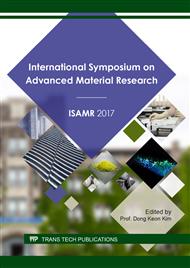p.50
p.60
p.65
p.71
p.78
p.84
p.93
p.99
p.103
Fabrication and Characterization of Magnetic Nanocomposite Powders in Hematite-Ca System by Mechanical Alloying
Abstract:
We have applied mechanical alloying technique to produce magnetic nanocomposite material using a mixture of Fe2O3 and Ca powders at room temperature. An optimal ball milling and heat treatment conditions to obtain magnetic α-Fe/CaO composite with fine microstructure were investigated by X-ray diffraction, scanning electron microscope and vibrating sample magnetometer measurements. We have revealed that the magnetic α-Fe /CaO nanocomposite powders can be produced by solid state reduction during ball milling. It is found that α-Fe/CaO nanocomposite powders in which CaO is dispersed in α-Fe matrix with a grain size of 45 nm are obtained by mechanical alloying of Fe2O3 with Ca for 5 hours. The saturation magnetization of ball-milled powders increases with increasing milling time and reaches to a maximum value of 65 emu/g after 7 hours of MA. The average grain size of a-Fe in 5 hours MA powders estimated by diffraction line-width are gradually decreased with increasing milling time, and tend to reach at 45 nm. The magnetic hardening due to the reduction of the α-Fe grain size by MA is also observed.
Info:
Periodical:
Pages:
78-83
Citation:
Online since:
August 2017
Authors:
Price:
Сopyright:
© 2017 Trans Tech Publications Ltd. All Rights Reserved
Share:
Citation:


